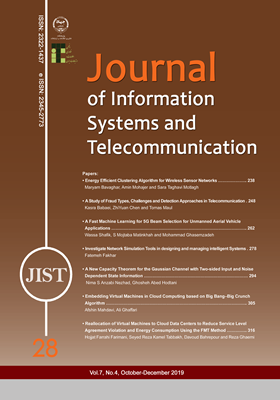-
-
List of Articles
-
Open Access Article
1 - Energy Efficient Clustering Algorithm for Wireless Sensor Networks
Maryam Bavaghar Amin Mohajer Sarah Taghavi Motlagh -
Open Access Article
2 - A Study of Fraud Types, Challenges and Detection Approaches in Telecommunication
Kasra Babaei ZhiYuan Chen Tomas Maul -
Open Access Article
3 - A Fast Machine Learning for 5G Beam Selection for Unmanned Aerial Vehicle Applications
Wasswa Shafik Mohammad Ghasemzadeh S.Mojtaba Matinkhah -
Open Access Article
4 - Investigate Network Simulation Tools in Designing and Managing Intelligent Systems
fatemeh fakhar -
Open Access Article
5 - A New Capacity Theorem for the Gaussian Channel with Two-sided Input and Noise Dependent State Information
Nima S. Anzabi-Nezhad Ghosheh Abed Hodtani -
Open Access Article
6 - Embedding Virtual Machines in Cloud Computing Based on Big Bang–Big Crunch Algorithm
Ali Ghaffari Afshin Mahdavi -
Open Access Article
7 - Reallocation of Virtual Machines to Cloud Data Centers to Reduce Service Level Agreement Violation and Energy Consumption Using the FMT Method
Hojjat Farrahi Farimani Davoud Bahrepour Seyed Reza Kamel Tabbakh reza Ghaemi
-
The rights to this website are owned by the Raimag Press Management System.
Copyright © 2017-2025







